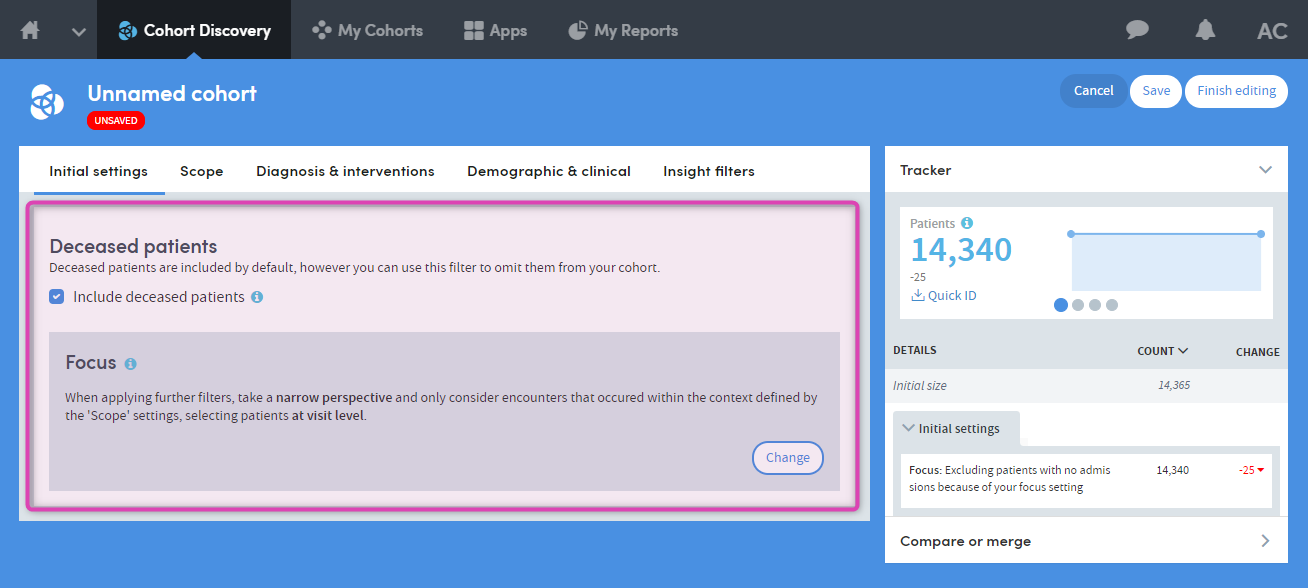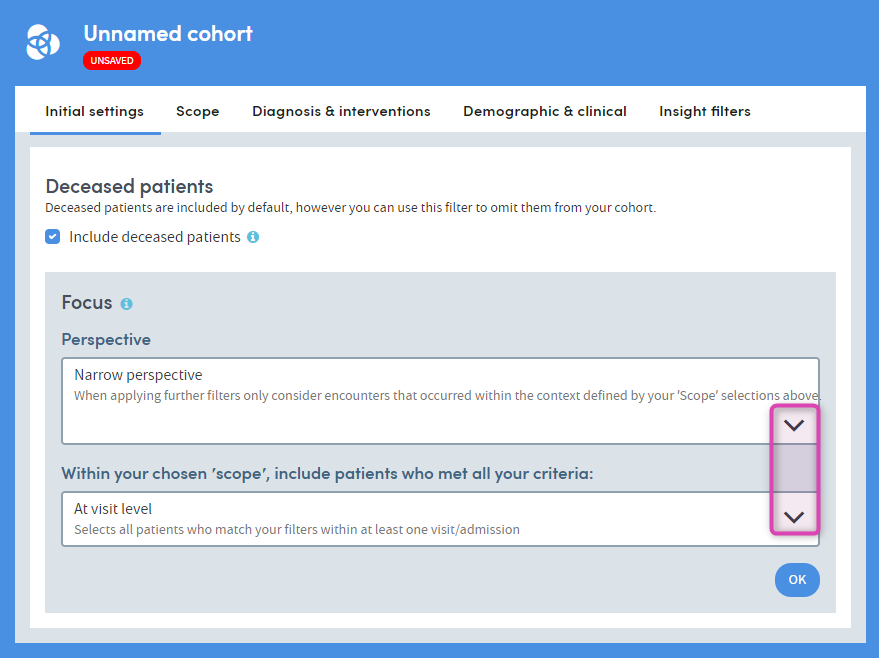Initial settings
Within the Scope section of Cohort Discovery, you’re setting the clinical context of the patients in the cohort you’re creating. You use the Scope settings to determine, for example, which hospital the patients were admitted to, under the care of which clinician, during which period of time. You’ll use other features of Cohort Discovery to apply filters using clinical, demographic or diagnostic criteria.
The Initial settings screen determines the ‘area’ from which the patients in your cohort will be selected.

It has two parts, Deceased patients and Focus
Deceased patients
You can choose whether to include deceased patients in your cohort. Unchecking this option will exclude all patients with a recorded date of death, regardless of whether they were deceased during any time frame you may select.
Focus
Focus has two drop-down options: Perspective and …include patients who…

Perspective
Perspective has two options: Narrow perspective and Broad perspective. Narrow perspective is selected by default.
An example will help to clarify the difference between Narrow perspective and Broad perspective.
We’re using Admission type, clinician, and a diagnostic filter here, but the same rules apply to any of the Scope settings (Patients, Clinicians, Time frame) and any subsequent filter criteria (diagnoses, test results, etc).
Our Atmolytics user, Jane Smith, creates a cohort by setting the following Scope parameters:
- Admission Type: Dental
- Clinician: Dr Robinson
One of the members of Jane Smith’s base cohort is Patient A. Patient A had a dental admission where the clinician they saw was Dr Robinson. Patient A was also seen by Dr Stuart in a separate inpatient admission, where they were diagnosed with diabetes. Since they match the Scope criteria of a dental admission with Dr Robinson, they’re included in the new cohort at this point.
Next, Jane Smith creates a Diagnosis & intervention filter to find patients assigned a diabetes diagnosis.
Narrow perspective
Narrow perspective means the Scope settings will remove all admissions apart from the ones where the patient attended Dental and the clinician was Dr Robinson. All subsequent filters (i.e. the diabetes diagnostic filter) will only be applied to Dental admissions where the clinician was Dr Robinson.
Choosing Narrow perspective here would mean that in this case, patients would only be included in the cohort if they had been assigned a diabetes diagnosis during a dental admission with Dr Robinson.
Patient A would no longer be included in the cohort, despite their diabetes diagnosis, because they were diagnosed with diabetes by Dr Stuart during an inpatient admission, NOT by Dr Robinson during a dental admission.
Broad perspective
If Jane Smith chooses Broad perspective, the Scope settings will still remove all admissions except the ones where the patient attended Dental and the clinician was Dr Robinson. At this point, Jane’s new cohort will still contain the same number of patients as it would using Narrow focus.
However, all subsequent filters (i.e. the diabetes diagnostic filter) will be applied to all admissions for the identified patients, regardless of the type of admission or the clinician (however, the total ‘pool’ of patients is always limited to those in Jane Smith’s own base cohort).
As we are now considering all admissions belonging to dental patients seen by Dr Robinson, Patient A is included in the cohort. Dr Stuart diagnosed Patient A with diabetes during an inpatient visit, but because Broad focus includes all admissions for Patient A, they would now meet the criteria “Diagnosis of diabetes”.
…include patients who…
The various clinical, demographic or diagnostic filters you may choose to specify can be applied at one of two levels: the patient level or the visit/admission level. If applied at admission level, they may be applied across all admissions or across only the most recent visit/admission for each patient.
At patient level. If filters are applied at patient level, then all patients will be identified for whom all filters are or have been true at some point in time. However, these options need not have been true concurrently. So, for example, a patient may have had a headache at some point in their life and may also have taken paracetamol but may never have taken paracetamol to treat a headache. Nevertheless, they will be identified as a member of the cohort if both statements are true.
At admission/visit level. In contrast, if filters are applied at admission/visit level then a patient will only belong to the cohort where had a headache=true and taken paracetamol=true if both statements were true within a single admission (regardless of when this single admission took place). This option therefore captures a strong element of what might be meant by the filters being true ‘concurrently’.
To most recent admission/visit. In this final case the filters are applied only to the most recently-commenced data collection for each patient rather than to all historic instances. So, for example, if you wanted to identify all patients who upon their most recent discharge had a headache and were taking paracetamol then you would select Have a past admission under Scope, headache=true and paracetamol=true under clinical filters and apply this most recent clinical filter to the data.